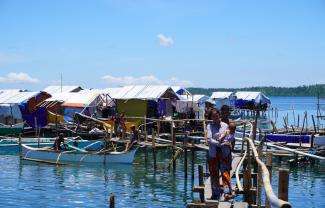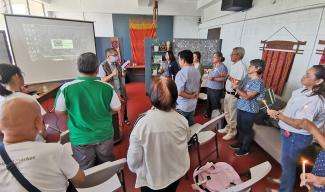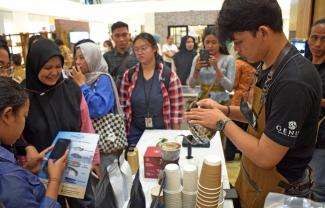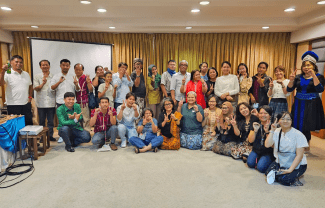By: Bibing Mordeno/ Samdhana
The Badjao are an indigenous group in the Philippines, known as sea nomads. According to a study[1], they have been in the country since 500AD; described as endemic fisherfolks who have been using sustainable fishing methods for over 1,500 years. They are categorized as the 13th Moro ethnolinguistic grouping[2], not necessarily by mutual agreement but rather because of their traditional habitation in the waters of what we refer to as the pre-Martial Law unified Sulu islands consisting of the three provinces of Sulu, Tawi-Tawi and Basilan, a predominantly Moro territory. Samdhana Institute formally supported almost 200 Badjao families in Barangay Canlanipa, Surigao City, Surigao del Sur in December 2021; through the recommendation of staff who have come to know them more closely and more deeply for almost five years now. Of the 54 barangays in the city, it is only Canlanipa that accommodated and opened up their territorial jurisdiction to these sea nomads.
The population of Badjaos in Surigao City is reported at 2,000 individuals, but there is probability that this is inaccurate because of their high mobility. For a variety of reasons, including ongoing violent conflicts and the neglect of their sea-based existence, they have become urban nomads, known for begging alms and travelling to other cities and towns far from Surigao.
In Canlanipa, the Badjaos live at the city port. The Daughters of Our Lady of the Sacred Heart (DOLSH)[3] supported and accompanied them to undergo various capacity development interventions such as mat-making, sewing, dressmaking, cooking of pastries, and planting of vegetables. According to DOLSH sister, Catherine Biyo, fewer Badjaos were seen soliciting alms during this period.
DOLSH’s program eventually gained support from the Roman Catholic Diocese of Surigao through the Social Action Center-Indigenous Peoples Apostolate (IPA). Previously, the Surigao IPA only had a program for the Mamanwa Indigenous tribe.
At the height of the COVID-19 pandemic in year 2020, the Badjao families were also drastically affected and their poverty multiplied. Some families returned to the streets. To make matters worse, typhoon Odette (international name Rai), categorized as the strongest typhoon of the year, struck in December 2021. The Badjao community was forced to evacuate by the Local Government Unit (LGU) to the city cockpit, which for almost two years was neither used, nor cleared of the overgrown grass, nor cleaned up. They were also not provided with any basic amenities such as bedding, drinking water, or food. However, scared by the rising flood waters and power outage, they decided to leave the place, walked under the heavy rain toward the city terminal and stayed there until the morning.
Through the urgent action grant, Samdhana contributed to providing the needs of the Badjao families who lost practically everything they had – their shanty homes and meager belongings. Other groups such as the Surigao-IPA, Columban Missionaries, the International Organization for Migration (IOM), and the government’s social welfare office also shared some goods for emergency relief and recovery.
In the succeeding consultations, Dahila Amad Araman, the Badjao community leader, mentioned about their relocation problem, which if not readily addressed, will burden them further. She said that after typhoon Odette, they were told they could no longer go back to live at the city port, since the city LGU had plans to develop the area. Their houses were in the danger zone, and also posed a contradiction to the city's tourism. These were statements that some of the Badjaos directly heard from various government officials.
In a multi-agency meeting before the May 9 elections, they were informed to prepare for their relocation to Purok 5, still in barangay Canlanipa. However, the present administration have not acted on this. They fear another typhoon event, which is unfortunately frequent in the province, since it is the usual typhoon pathway in the country. Some families have been living in make-shift houses along the city streets for the last eight months and at least two (2) young children have been victims of hit-and-run.
The Badjao group also complained about the absence of records in the city registry, though they participated in the 2022 elections. “Granting that the Badjao has already existed since 500AD, we should have been enjoying the recognition of rights and ownership of territories ‘since time immemorial’[4]. Why didn’t the NCIP[5] tell us about the need for an Indigenous Political structure? The NCIP Office should have disseminated all these information to us”, Dahila lamented.
The Badjao’s sincere appeal is for the government to finally facilitate their permanent relocation. As much as they desired a better and safer environment, their status as indigenous peoples and their cultural practices should be taken into account. And this goes true for all Badjaos scattered around the country: the concerned LGU should attend not only to their practical needs, but also to their strategic needs. ###
[1] https://www.badjaobridge.org/sea-tribes
[2] Presentation of Atty. Laisa Masuhud Alamia addressed to the United Nations Office of the High Commissioner for Human Rights Sub-Committee on Human Rights Promotion and Protection Working Group on Minorities 11th Session, May 30-June 3, 2005, Palais d’Nations, Geneva, Switzerland
[3] An international congregation with a missionary orientation of bringing the love of God to people everywhere
[4] As provided for in the Indigenous Peoples Rights Act (IPRA) or RA 8371
[5] National Commission on Indigenous Peoples




